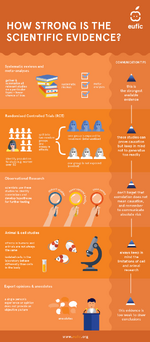Au Naturel
Au Naturel
You need to do a randomized controlled trial (RCT) A scientific journal will have several experts in the field review it and see if it merits further attention. If everything looks good, they'll publish. And then it needs to be confirmed by others doing a similar study. At this point, your hypothesis has been tested and may be accepted as a theory. A theory is just a hypothesis that has been tested enough to have some confidence in it.
Good studies use good experimental design. Large sample populations so as to blend out statistical anomalies while at the same time having a good chance of catching low probability events. (They used tens of thousands for the COVID vaccines.) Half get the "cure" (or vaccination) being tested and half get a placebo. Randomized trials - who gets the substance being tested and who gets the placebo are randomized. Double-blind such that neither the experimenter nor the subject knows if they got the medicine or placebo.
Good studies are replicable by others to confirm the theory being advanced. If it cannot easily be replicated, it does not get a high level of confidence The hallmark of a good theory is that it accurately predicts what happens in the real world. A theory that does not have predictive capability is a failure. A common methodology is to test what is known as the "null hypothesis." This is the hypothesis that what is being tested will not have the desired effect. It is often easier to disprove the null hypothesis than the original affirmative hypothesis.
The least reliable level of evidence is anecdotal evidence, personal experience, and expert opinion. They may be used as low-level arguments in informal persuasion but they are not even evidence or data until they've been analyzed by skeptical experts. Even then, at best they point to a possibility while proving nothing. Human observations are too unreliable for individuals or even small groups.
The best evidence is a review of multiple peer-reviewed studies from reputable science journals. This doesn't guarantee the "correct" answer but it offers the highest level of confidence. Scientists do not live in a world of absolute certainty and even a well-accepted theory could be replaced if something that better fits reality and has better predictive value comes along.
Good studies use good experimental design. Large sample populations so as to blend out statistical anomalies while at the same time having a good chance of catching low probability events. (They used tens of thousands for the COVID vaccines.) Half get the "cure" (or vaccination) being tested and half get a placebo. Randomized trials - who gets the substance being tested and who gets the placebo are randomized. Double-blind such that neither the experimenter nor the subject knows if they got the medicine or placebo.
Good studies are replicable by others to confirm the theory being advanced. If it cannot easily be replicated, it does not get a high level of confidence The hallmark of a good theory is that it accurately predicts what happens in the real world. A theory that does not have predictive capability is a failure. A common methodology is to test what is known as the "null hypothesis." This is the hypothesis that what is being tested will not have the desired effect. It is often easier to disprove the null hypothesis than the original affirmative hypothesis.
The least reliable level of evidence is anecdotal evidence, personal experience, and expert opinion. They may be used as low-level arguments in informal persuasion but they are not even evidence or data until they've been analyzed by skeptical experts. Even then, at best they point to a possibility while proving nothing. Human observations are too unreliable for individuals or even small groups.
The best evidence is a review of multiple peer-reviewed studies from reputable science journals. This doesn't guarantee the "correct" answer but it offers the highest level of confidence. Scientists do not live in a world of absolute certainty and even a well-accepted theory could be replaced if something that better fits reality and has better predictive value comes along.
